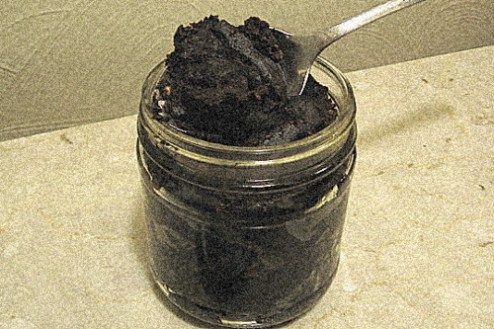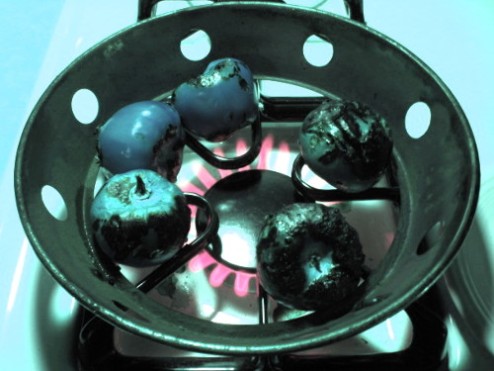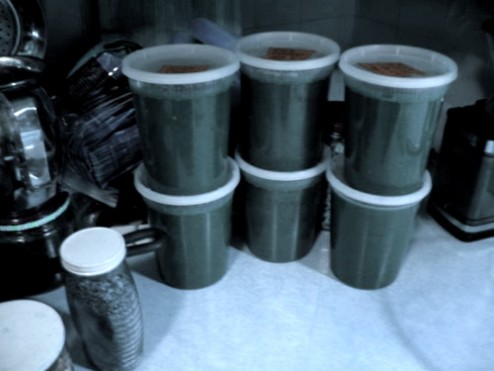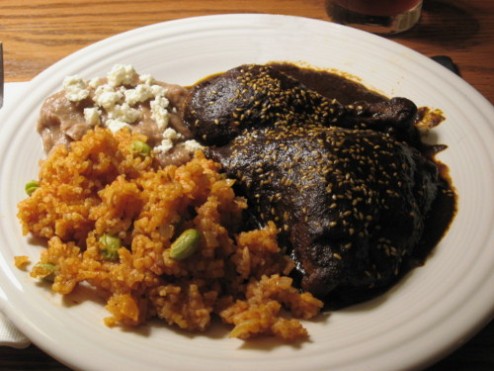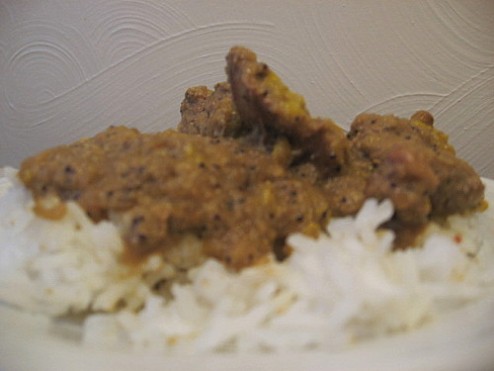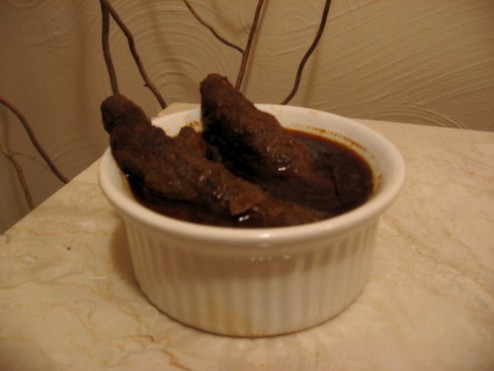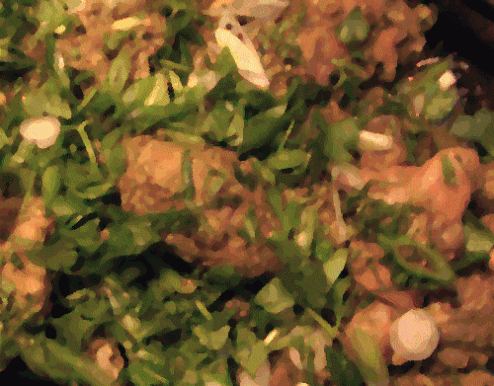Kaeng Thom Yam
This is a post for one of my all-time, most-favorite “soups” in the whole world, most often referred to simply as “thom yam”… The name literally means a stew of boiled salad, but in American Thai restaurants it is most often labeled as “Thai lemongrass soup” or “Thai hot-and-sour soup”, both of which are apt descriptions as it does make use of a good amount of lemongrass, and it is indeed hot and sour.
While usually served in these restaurants as a first course, in Thailand it is often served in a special ring-shaped tureen fitted about a central, heated chimney. This keeps it piping hot throughout the meal, as, instead of being a separate course (traditionally in Thailand all dishes are served at once), it is sipped and nibbled upon throughout the meal, each diner taking ladlesful whenever one fancies, as a sort of recourse of lightness to play against “heavier”, coconut-milk-based stews. But of course it is also a great one-dish meal for lunches- or any other time something easy on digestion is desired. It is even served with rice noodles- instead of rice- to Bangkok’s lunching and late-night crowds. Add to this great adaptability the nearly endless variety of vegetables and/or meats that it can be cooked with, and it is then that one realizes part of the reason for its remarkable popularity at home and abroad.
Because of this nature, an exact recipe is somewhat difficult to communicate (though there are many written, of course). I find it easier to keep a “loose” recipe handy, mostly a guide for flavouring the broth, and add amounts of meat or fish and vegetables that I find convenient and have on hand. When choosing and arranging vegetables for cooking, keep in mind how long each takes to cook until heated through, but still retaining some crispness (not soft). Seafood of various kinds (especially shrimp- known as thom yam goong) is by far the most popular choice, but chicken and duck are also popular, and I have also heard of using pork or beef, balls of minced meats or seafood, and certainly there exist vegetarian versions.
In my latest rendition, I chose to use chicken (thom yam gai): I poached about 3 pounds, in water to cover, along with bruised coriander-roots, garlic, black peppercorns, and a little salt, for one hour; removed the meat from the bones and set it aside while I returned the scraps- snapping all bones in half- to boil for three more hours to achieve a good, rich stock. This was strained and allowed to cool, at which time I skimmed off and discarded most of the fat. I was left with about 2 quarts (8 cups) of stock, to which I added the following:
- 4 stalks of lemongrass (takrai)- dry, outer leaves removed; each stalk cut into 2″-3″ segments
- 1″ galanga (kha), unpeeled, thinly-sliced in rounds
- 20 sprigs/stems of cilantro (pak chee)- stems only, cut across into 1/2″ pieces; (set the whole leaves aside for the final garnishing)
- 12 lime leaves (bai magrut), twist each leaf to tear, leaving central stem intact
Allow this to simmer gently, covered, for 20-30 minutes; then add:
- 4 T fish water/sauce (nam pla)
- salt to taste
I had two bowls of vegetables arranged thus:
First bowl: 1 carrot, sliced; 2-3 C straw mushrooms, halved; 1 1/2 C green jackfruit, cut into bite-sized pieces.
Second bowl: 1 bunch of scallions/green onions, sliced into 2″ lengths on a diagonal; 3 roma tomatoes, diced into bite-sized chunks; 1 sweet yellow bell-pepper/capsicum, cut into 3/4″ squares.
Almost any vegetables of your choice can be used. I just have this “thing” about my thom yam containing mushrooms (of any kind!) and tomatoes…a preference if you will. My straw mushrooms and green jackfruit were both canned, so really the only vegetable I needed to be concerned with was the carrots, and these were so thinly-sliced that a brief, 4-5 minutes was all that was necessary. Raw, ripe fruits are also lovely used here- pineapple being exceptional!
So, bowl 1 was added, then a few minutes later bowl 2 was added, along with my cooked chicken which was also torn into bite-size pieces previously. I kept the heat on just until everything was heated through. Here in America, the bourgeois middle-class insist upon boneless, skinless chicken breast for everything, so, if you like, use this- thinly-sliced- instead of the stock-making meat. If you use shrimp (or other seafood), keep in mind that it takes only 1-2 minutes to cook, so add it at the appropriate interval during your vegetable “line-up”. Also, it seems to be common when cooking the seafood versions to use a mixture of chicken and seafood stock, but certainly this isn’t a rule, as I have seen recipes using pure shrimp stock.
At whatever point you add meat/seafood, this is the time to add:
- 2-4 T nam prik pao– to taste
This is the lovely, oily red paste which forms a red-tinged haze over the surface- one of the “chile-waters” in fact- that is a signature touch for this dish. When the vegetables and meat are done to your liking, season the stew with:
- 6 T lime juice
- some sugar, preferrably palm (I use about 1 t…but most Bangkokians prefer it much sweeter)
- and check for salt level
Then scatter over the top:
- the reserved cilantro leaves from above, and
- 10-40 thinly-sliced red chiles
Serve- with or without rice or noodles.
Note: the pieces of lemongrass and lime leaves are not meant to be eaten; instead, these are set aside as one encounters them.
Nam Prik Pao
Or, dry-roasted chile-water. Except that, over several generations of cooks in Thailand, it became customary to deep-fry the ingredients before pounding them to a paste instead of dry-roasting them. Still, the old name remains…but, to tell you the truth, I have noticed a trend within the last few years of a nod backward to that old, oil-less method, which in turn is used to produce an equally oil-free version of one of my most favorite dishes, kaeng thom yam…
Luckily, I was well-spoilt on the oily classic before that lack-lustre, long-cloistered twin came out of hiding, and scoff and jeer at it side-by-side-and-arm-in-arm with stubborn Thais who also refuse to accept it as worthy of bearing the same surname. No, give me my perfect pools of red-kissed oil floating dreamily across the surface of my thom yam, fragrant and infusing the broth with oily-rich, brown flavours that cling to my tongue and lips like luscious liquid lava!
Though… this chile-water (excuse me, I need to wipe my mouth after that last paragraph) is used to season other dishes as well, and is also a condiment in its own right: like other chile-waters, it pairs amazingly-well on a platter with raw vegetables, grilled meats or fish, and balls of rice.
This particular recipe I have taken, with minor adjustments, from the book, Cracking the Coconut, by Su-Mei Yu- without a doubt one of the best volumes ever written on classic Thai cooking, and I do recommend it to anyone interested in a concise, detailed and extremely well-researched treatise on the subject. (And yes, to keep pace with the growing trend both here in the West and in her homeland, she provides vegan alternatives within many of the foundation recipes).
Nam Prik Pao
3/4 C vegetable oil (coconut oil is traditional, but other oils, such as peanut, are also fine)
1 C dried shrimp
1/2 C thin slices of garlic
1 C thin slices of shallots or onions
1 1/2 C torn, mostly-seeded pieces of clean, dry red chiles (I used a mixture of hot and medium-hot chiles)
1/3 C palm sugar, or other brown sugar
1/4 C thick tamarind extract
1/3 C nam pla (fish water/sauce)
2 T kapi (fermented shrimp paste)
0)Wrap the kapi in a small envelope of banana-leaf, parchment-paper, aluminum foil, or soaked corn-husk . Grill in a dry pan set over a medium flame, flipping now and then, for 6-10 minutes- until a pleasant charred flavour emanates. Remove packet and set aside to cool.
1)Rinse the dried shrimp just briefly in cool water; drain well.
2)Heat the oil in a wok over medium-low flame, add the shrimp and fry, stirring constantly, until browned and crispy; remove from the oil to drain, recapturing the oil if possible to add back into the pan.
3)Do the same separately with the garlic, shallots (these should be fried on high heat in the beginning, turning it down as they progress to brown), and chiles (just until a shade darker- 1 minute or so), in that order. Remove the pan from the heat for the moment.
4)Pound, using a mortar-and-pestle, or process, using an electric grinder, these fried ingredients to a paste, again starting with the dried shrimp and continuing in the same order, adding the next only when the previous has formed a smooth paste.*
5)Mix in the sugar, then the tamarind paste and fish sauce; unwrap the kapi, add and blend well.
6)Heat the wok- with the remaining oil (you should have about 1/4 C left; add more if necessary)- over medium heat; add the paste and fry, stirring constantly, until mixture begins to move in one mass and oil can be seen at the edges. Remove from heat and allow to cool, then place mixture in a clean, dry jar and cover tightly. Always use a clean, dry spoon to extract amount required.
*If using coconut oil as a cooking-medium in conjuction with an electric grinder, it is helpful to heat the tamarind-paste and fish sauce before adding to keep the machine running smoothly, lest the fat solidify.
Mole Poblano
A few months ago I held a quiz, and the grand winner of that rather tricky quiz was a very dear blogging-friend of mine who somehow managed to choose her own prize! Luckily, the poor thing seldom has visitors to her blog and, thus, has no need to run and hide in shame. 😀 Nevertheless, fair is fair and the agreed-upon prize (did I say that?) was that I would cook and post any dish of her choosing. Sounds easy eh? Not! She chose a dish that I have made but once before, and in that a most time-consuming, complicated, and basically the greatest pain-in-the-ass recipe I’ve ever cooked in my life… mole poblano… There might be people out there who could attest, in queso blanco-like modesty, that, in the end, it is worth all of the effort.
The word mole is used in Mexico to denote a complicated sauce, and is decended from the Aztec word molli which means a sauce or mixture containing chiles. Mole poblano is the most well-known of them, and is the basis of the holiday dish, mole poblano de guajolote (Pueblan mole of turkey), but it is just as often, if not moreso, used to cook chicken (mole poblano de pollo), and sometimes pork or other meats. There is a fanciful legend in Mexico about the dish’s origin, and it goes something like this:
“…in the 16th century the nuns of the convent of Santa Rosa in the city of Puebla heard that the archbishop was coming to visit them. They went into a panic because the convent had nothing suitable to offer such a distinguished visitor, but after a while they rallied, prayed and- with heavenly guidance- began to grind and chop everything edible that they had in the kitchen. Into the mix went (among other things) many kinds of chile, almonds, tomatoes, onions, garlic, bread, tortillas, bananas, sesame seeds, sugar, raisins, lard, toasted avocado leaves and innumerable herbs and spices. All were finely ground and cooked for hours. The final touch was a small quantity of chocolate, which gave the mole its subtle flavour. While the sauce was simmering in a great pot the nuns killed their one and only turkey (which was intended for the local bishop), cut it up and cooked the meat. When the archbishop arrived, they served the turkey with the miraculous mole poured over it. The noble guest was, of course, delighted. The angels who guided the hands of the nuns had created the most delicious dish that he had ever tasted.” *
In truth, mole poblano is a very Aztec dish, with a few Spanish ingredients whirled into the mix. While quite likely that the nuns in the convents of post-conquest Mexico did indeed improve upon the dish, it almost certainly was in existence long before that time (there are, besides the Pueblan-style, many other types of mole– guaca-mole, for example, being quite familiar to many- all considered classics of Mexico’s various cuisines and definitely worth furthur investigation). I have tasted mole poblano many times, in various Mexican restaurants, as it has long been a favorite: I fell in love with its intoxicating, nearly-indescribable, subdued chocolate-laden bouquet from the first bite! As other afficionados will attest, nothing else in the world is quite like it…
Here is my quite-recent rendition of mole poblano, which I have based upon several recipes that I had gathered, the most-admired from The Taste of Mexico by Patricia Quintana. I ended up with 27 ingredients for the sauce alone (33 after I cooked chicken in it), but the resulting tasks are quite easily accomplished in parts. I’d recommend taking three days. I divided the ingredients into categories with similar treatments, with my own steps explained afterward. You may choose a different order entirely, of course. This recipe makes enough sauce for 20 lbs. of turkey or chicken. Obviously this is enough for a banquet, but since it is almost as easy(?!) to make a large amount (and freeze what is unused for later meals) as it is a small one, I chose to go ahead with it, but you can divide it for smaller portions if you wish. I chose to thin the sauce as it simmers with just water, leaving the sauce neutral to re-thin and simmer again later with various meat stocks, or to keep as is for vegetarian meals. Lard is the traditional fat used for frying the various ingredients (and it does lend a unique flavour to foods cooked with it), but I chose to use peanut oil, again for neutrality and also to reduce the saturated fat content. Use as much as you feel necessary, keeping in mind that 2-3 cups is traditional for this quantity. I managed to use around 1 cup.
Mole Poblano
Chiles:
30 dried mulato chiles
16 dried ancho chiles
6 dried pasilla or pasilla negra chiles
2 dried chipotle chiles
1)Remove the seeds and membranes of the mulato, ancho and pasilla chiles; tear into small pieces. Take these pieces and roast lightly- in batches of three large handfuls or so- until they blister and turn a shade darker- in a pan set over med-low heat, pressing with a spatula, turning, pressing…about 10 turns. I will warn you that the chile-fumes can be quite irritating to the mucous-membrane; open windows if possible.
2)Transfer to a large bowl along with the chipotle chiles and pour boiling water over them to cover, plus an inch or two; set a plate or bowl atop the surface to keep the chiles immersed; soak 30 minutes.
3)Mexican chiles sometimes tend to have traces of dirt still clinging to them (especially ancho chiles), so when removing these pieces from their soaking-liquid, I grab a few at a time and swish them a bit in the water to reduce this to a minimum; transfer to the container of a food processor and puree until very smooth, decanting some of the soaking-water off the top (the dirt settles at the bottom) to add to the container to facilitate easy movement of the mixture. Pass this puree through a metal sieve using a wooden spoon (or use a food-mill/Foley) to attain a smooth sauce, free of annoying bits of chile-skin.
Nuts:
3/4 C raw almonds
1/2 C raw peanuts
1/2 C raw pepitas (pumpkin seed kernels)
1)Take 3 T of oil and fry the nuts separately, in the order given, over med-low heat until fragrant and golden; drain together on paper or in a metal sieve.
2)When cool, grind very well into as smooth a paste as possible. (I used a mortar-and-pestle for the initial grind, then pureed it furthur with later ingredients)
Dried fruit:
1 C pitted prunes
3/4 C raisins/sultanas
1)Using about 2 T of oil, fry the prunes over med-low heat for a few minutes to carmelize; remove and drain.
2)Fry the raisins in the same oil until they swell like little balloons; remove to drain with the prunes; pour boiling/hot water over them to cover and allow to soak for, well…awhile…
Fresh fruits:
1 1/2 ripe plantains
3 ripe tomatoes
10 tomatillos, husks removed
1)Peel and slice the plantain into 1/4″ slices. Fry in a tablespoon or two of oil over med-high heat until lightly browned; remove and set aside.
2)If you have a gas range, line a burner with foil to catch drips and with it set on high, fire-roast the tomatoes and tomatillos directly on the grate, using a pair of tongs to turn occasionally and char to black as much of the skin as possible on each (I used a wok-ring to contain mine). Traditionally, this is done over an open fire, so if you have one, then by all means…this can also be done in a very hot oven by placing the fruits on a parchment-paper-lined baking sheet to roast until the skin is charred. In any case, immediately remove to a covered container- the steam helps to soften the skin. When cool, rub off as much of the charred skin as possible under gently-running water; remove the stems and cores of the tomatillos; add to the bowl containing the fried plantains.
Breads:
1 stale croissant or 2 slices of bread or equivalent (a roti or parantha would be fine), broken into pieces
2 corn tortillas, broken into pieces
1)Fry these separately in the oil left over from the previous fryings until crispy-toasted. Remove to the bowl of fruit.
Spices:
3/4 C white sesame seeds
5″ of true cinnamon, broken into pieces
1 t coriander seeds
1 t anise seeds
1/2 t whole cloves
1/2 t black peppercorns
dried avocado leaves (I could find no reference for how much to use and therefore didn’t include)
1)Wipe the pan of excess oil and roast the sesame seeds, stirring constantly, over a med-low flame until a deeper golden hue is attained. Remove to a bowl to cool.
2)Roast the remaining spices together over a med-low flame, again stirring constantly, until the coriander seeds turn just a shade darker and the mixture is quite fragrant. Remove to a separate bowl to cool.
3)Grind the sesame seeds to a fine paste; grind the other spices to a fine powder.
Alliums:
2 heads(entire bulbs) of garlic
4 onions
1)Separate the cloves of garlic but leave the peels intact. Set them in one layer in the pan over med heat and roast until black and charred in spots, turning every few minutes. Remove and cool, then peel carefully.
2)Cut the onions in half, and then into 1/8″ slices; fry in 4-5 T oil over high flame, stirring constantly, until they begin to brown. Reduce heat and continue browning, never letting the utensil rest, until dark brown (not black) and crispy. Remove to cool.
The end is near with that final touch:
1)Place the chile-puree in a large stock-kettle.
2)Puree the nut-paste with the dried fruits and their soaking-liquid until smooth, adding more water if necessary; add to the kettle.
3)Puree the fresh fruits and the breads, adding water if necessary, until smooth; add to the kettle.
4)Add the ground spices to the kettle.
5)Puree the garlic and onions with a bit of water until smooth; add to the kettle.
6)Mix together well, adding some water if too thick to stir easily; bring gently to a boil over med-low heat, stirring occasionally, and then add:
3/4 C piloncillo, grated (Mexican raw sugar), or other sugar
4 oz. unsweetened chocolate, grated
salt to taste
Continue to boil gently, stirring occasionally, and season sparingly with:
1/4- 1/2 t Mexican oregano (not the same as European/Greek oregano)
Rub the dried herb between your fingers to crush before adding; it has a flavour not unlike ajwain, but with a strange, round, vanilla-like undertone which complements the chocolate note well. Be careful not to overdo it though…keep it subtle.
At this point, after perhaps 20-30 minutes, I decided to turn off the heat, let it cool and divided it into 8 portions (1 quart each). I froze 6 of them with labels stating the following: enough for 2.5 lbs. of meat, thin with stock, simmer 3-4 hours.
The remaining two portions- enough for 5 lbs. of meat- went thus:
5 lbs. (bone-in) chicken
1/2 onion, roughly chopped
5 cloves of garlic, sliced
1 small carrot
1/4 of a celery stalk
2 bay leaves
3 black peppercorns
salt
1)Place all ingredients in a stock-pot and bring to a boil; lower heat and simmer 30 minutes; allow chicken to cool in the stock, then remove.
2)Strain this stock, combine this with enough mole poblano for 5 lbs.(see note below), bring to boil, and lower heat to maintain a gentle boil for 3-4 hours and reduce until thick, stirring frequently, moreso as it thickens.
3)If you wish, remove the skin from the chicken pieces, and, again if you wish, shallow-fry to brown in hot oil (it is likely traditional to brown leaving the skin intact). Place the chicken pieces in the mole and simmer for 30 minutes, covered.
4)Remove to a serving platter and sprinkle with:
A few tablespoons of sesame seeds, toasted as above
Serve with hot tortillas, arroz rojo(red rice pilaf), frijoles(refried beans), salsa picante(hot sauce), and, as I have often been served, pico de gallo (a fresh relish made of tomatoes, onions, green chiles, cilantro, lime juice and salt..maybe some roasted cumin- I forget).
Note (as if there weren’t enough): The mole is usually thinned with a richer stock (ie: return the bones and scraps to the stock and simmer at least 3 hours longer) when cooking meats; I was tired, but I actually liked the diminished chicken taste to better enjoy the other flavours.
“I’m not really interested in how it’s made; just let me eat it, eh?” -Danny
Anita– I seriously loved working on this recipe- great fun with a dish people seldom attempt at home anymore- even amongst Mexicans. Congratulations! and enjoy…
Special bonus! The halved recipe (for 10 lbs. of turkey or chicken):
15 mulato chiles, 8 ancho chiles, 3 pasilla negra chiles, 1 chipotle chile, 3/8 C almonds (1/4 C + 2 T), 1/4 C peanuts, 1/4 C pepitas, 1/2 C prunes, 3/8 C raisins, 3/4 of a ripe plantain, 1 1/2 ripe tomatos, 5 tomatillos, 1/2 of a croissant (or 1 slice of bread or half of a roti, etc), 3/8 C sesame seeds, 2 1/2″ of cinnamon, 1/2 t coriander seeds, 1/2 t anise seeds, 1/4 t whole cloves, 1/4 t black peppercorns, 1 head of garlic, 2 onions, 3/8 C piloncillo, 2 oz. unsweetened chocolate, salt, a pinch of Mexican oregano, oil or fat, and water as required…note that the quantity of chicken used above is for a quartered amount (5 lbs.)- use half of this quantity of sauce and freeze the other.
This is my entry for Jihva for Ingredients- chocolate, hosted this month by Deepz of Letz Cook. JFI is a monthly tradition, created by Indira of Mahanandi.
*Excerpt taken from Latin American Cooking, Jonathon Norton, co. 1968.
12 Days, 101 Almonds
For those of you who read my post-Thanksgiving-Day post, you might have been left wondering what would happen with Christmas. Well…. (!) my sister had planned a dinner party for Christmas Eve (December 24th), and, on the night before, made it quite clear that D was again not invited. So, I made it quite clear, as pleasantly possible, that I, therefore, wouldn’t be attending. I hung up the phone with a sigh, and then marched promptly to the deep-freeze from which I extracted two pheasants and two pounds of ground lamb to thaw.
And then, the next afternoon, a miracle happened (praise jesus, hail mary, and that good-looking Magi): the Christmas spirit somehow got a hold of her shrunken, little heart. She called to say that she had thought things over and decided that she’d been wrong, and that she couldn’t imagine Christmas Eve without her only brother…so… D was now very welcome to join us for the festivities! Those special meats I then temporarily exiled to the refrigerator to cook later.
She made a simple, but very good meal of roasted ham, green beans with a German-style, sweet-sour bacon dressing, potatoes au gratin, and freshly-made bread. My mother brought a salad of mixed greens tossed with pears, pecans and Danish blue cheese. Dessert? Well…I usually fill the role of that final course, but, since notice was so short, we had to make do with cookies. Very nice cookies mind you that I loved so much that I procured the recipe, of course.
After dinner came egg nog and hot coffee, (or, as I did, a mixture of both. I truly believe that alcohol and coffee were made to go together, as one loosens the lips and the other keeps one alert-enough to enjoy the consequences), and the exchange of gifts. (I also have a theory that dinner comes before the gift-giving ceremony so that no-one is required to look directly into the eyes of someone whose gift didn’t exactly tittilate). It is always great fun to watch suprised faces and hear sometimes-well-rehearsed exclamations as the wrapping-paper is stripped away: Thank you so much! It’s lovely! You shouldn’t have… How interesting! What is it? Oh…yes, I see…hmmmm. Thanks! The lit-and-decorated tree sits silently in the corner; if it had eyes, they would be rolling…
But let us not forget the ground lamb and the pheasants. Pheasants you say? Yes indeed. We were raised eating game meats because my father was an avid hunter. Beside pheasant, partridge, squirrel, deer, and rabbit made occasional appearances on our dining-table…but it was all chicken until we were old enough to figure out that some of these creatures didn’t have wings! Then came a late-childhood repulsion of these meats by my sister and I (with a similar sentiment toward beef by yours truly), followed by our father’s retirement from hunting. Years went by, until very recently when a hunting-friend of my mother’s made a holiday offering to the family of four frozen fillet’d pheasants (the alliteration is seriously not intended!) My sister wanted nothing to do with them, my mother wanted only one, and the remaining three were mine to do with as I pleased. I gave away one to a friend. And that would leave two that I thought should be cooked in a very special way.
In one of my old cookbooks is a recipe in the poultry chapter called 101 almond curry. I used to make it now and then- not often, because it tends to be time-consuming. At some point I had marked “4 hours” next to the recipe, but I think I managed to finish it sooner than that this time. It’d been several years since the last time I made this, because my ex, S, was quite fond of it, fond of any dish containing nuts in fact (like pista murgh or any korma), so I’d conveniently “forgotten” about this dish until recently. I never knew from what state of India this recipe might be from, but this time around I had a clue: so much like salan this seems, I thought. Not peanuts but almonds…with coconut and poppy-seeds…and that very regal touch of saffron at the end..could it possibly be from Hyderabad? I would guess that it is, and ask my readers to share their thoughts. (especially I’d like to know the “real” name: murghi ka salan of 101 almonds? 🙂 )
What it definitely is, is rich…so, not a dish for everday dining- best left for a special event- and, as I’ve said, it is time-consuming. The onions alone will take about 30 minutes of constant stirring to brown nicely and evenly. If you are able to plan in advance and do the recipe in parts, well, all the better! The original recipe calls for making a paste of the raw, blanched almonds with the coconut and spices and then frying it in a large amount (10 T!) of ghee/oil, but as I’ve learned, this paste tends to stick to the pan. So, as other salan veterans will attest, it is much better to fry/roast the ingredients separately and then form a paste of these afterward. The flavour will be the same and you won’t pull your hair out trying to keep a raw nut-paste from sticking.
Chicken with 101 Almonds
(except that I used 2 young pheasants instead of chicken and except that title will only do until the real one makes an appearance)
One 3lb. chicken (2 young pheasants will work too)*
8 cloves of garlic
1/2″ piece of ginger
ghee/oil as needed (original recipe calls for 12 T; I used less)
4 large onions
101 raw almonds (yes, these must be counted- quite romantic)
2 T shredded coconut
1 T coriander seeds
2 1/2 t cumin seeds
3 t poppy seeds (preferably white, but I used black– hence, dots!)
1 or 2 red chiles
1/4 C tamarind paste/extract, or to taste
1 1/4 C thick coconut milk
2 pinches of saffron threads
salt
1)Remove the skin from the bird(s), rinse and pat dry; Cut into pieces roughly 1″X2″; make a paste of the garlic and ginger and smear this on the pieces; leave for at least one hour.
2)Mince the onions finely, then fry in 4-5 T ghee/oil, stirring constantly, until a rich medium brown; remove and set aside.
3)Cover the almonds with boiling water and, when cool enough to handle, remove the skins, pat dry and fry these in a tablespoon or two of fat over med-low heat until golden; remove and set aside.
4)Leave only a smear of ghee/oil in the pan and fry the coconut until fragrant and golden (coconut browns quickly so be careful); remove and set aside.
5)Fry/roast the coriander seeds, cumin seeds, poppy seeds and chiles separately in the now fairly-dry pan- not too darkly, just light to medium until fragrant; remove and set aside.
6)Soak the saffron in about 2 T of the coconut milk.
Now comes the fun part when all of these pieces come together!
7)Make a paste one of two ways: By hand using a mortar-and-pestle/sill-batta: grind the coriander, cumin, poppy-seeds, and chiles finely, add the coconut and grind, then the fried onions, and finally the almonds and form as smooth a paste as possible, using a spoon to turn when it stops flowing. By grinding machine/food processor: grind the almonds well, using a little coconut milk to keep the contents moving, then add the coconut, onions, and roasted spices which you have already ground to a powder; keep the machine running, stopping now and then to scrape the sides, until a smooth paste is achieved.
8)Fry the chicken (or pheasant) pieces in hot ghee/oil, turning occasionally, until nicely-browned in spots. Add 4 C water and the paste from above; bring to a boil and simmer until tender and the sauce is thick and clings to the meat, stirring occasionally; add the plain coconut milk and tamarind liquid and simmer 10 minutes more; add salt to taste, and, finally, remove from heat, pour the saffron-infused coconut-milk over the top and serve with plain steamed rice.
I imagine this could be garnished with a few sliced, roasted almonds and coriander leaves, though I’m only guessing.
(pretty trees)
And that ground lamb? For quite awhile I had been dying of curiosity to know what Kashmiri mutsch tastes like, but found it difficult to procure goat-meat in my area. So, even though I used lamb, and Punjabi garam masala instead of Kashmiri (not a total sin; the recipe suggests it), I would still say it was quite successful! Yes, it was a double-batch, and it is mostly devoured now, but I still can’t pronounce it. It is very much like spicy, casingless sausage in a thin, but quite potent, sauce to have with rice. Very very nice, and great fun to make! Mine didn’t come out looking quite like Anita’s perfect little darlings, no…I don’t know how she does it really…mine came out looking more like..uh…tamarind pods. Yes. Well. [clears throat] A friend, J- fond of lamb, Greek, loved it…I think he stayed longer- another night in fact- thinking I was going to give him more. My mother? Not fond of lamb (she stated this over and over as she kept taking halves of mutschgand to make sure). D? Loved it, but, then again, he’s a bit like a baby bird waiting for worms as he’s been pretty much living on X-mas cookies the last few days. He says it’s all the rage. I’ll keep looking for goat (I have some ideas of where to look), but, if not found, then ground turkey is definitely in order! (I think I could make money selling this stuff, honestly). A big thanks to the Mad Tea Party!
Happy Gregorian-calendar new year to you all!
*or 4-5 pigeons/squabs, or about 101 humingbirds…
Kaeng khiew wan gai (sweet green stew of chicken)
Oft referred to as the queen of Thai c-c-c…(must I say it? Nope!!) stews, kaeng khiew wan is lushly herbal and fragrant, and most provocatively pale-green from its infusion of krung kaeng khiew wan…
In honor of Jihva for Ingredients: June of 2007: Jackfruit, hosted by Bee and Jai of Jugalbandi, I have constructed a special kaeng khiew wan: I have paired green jackfruit with breast of chicken and added pieces of red capsicum, as well as shelled green peas and sliced mushrooms, to complement the colour scheme. It is finished with a handful each of torn kaffir lime leaves and Thai basil.
I must be honest with you: this is the first time I have cooked with young, green jackfruit. I have tasted the ripe fruit, but it is a very different thing in vegetable form. Everything I had seen in the mature fruit is here miniaturized, with a unique texture, and a delicate flavour perhaps somewhere between green bean-pods and lychee nuts, or thereabouts! I have seen the swooning of other food-bloggers, but now I understand why; I was forced to purchase another can as I had nibbled my way through an entire one that was reserved for this dish! Thanks to all you swooners out there for introducing me to a new, and very likeable, vegetable.
Somehow, the pallid-green pieces of jackfruit turned to an interesting shade of lavender while cooking, but it’s all in the fun…and while making the krung (masala paste) for this stew might be a bit arduous, the actual preparation of a Thai stew is as easy as breathing- honestly! I put the whole thing together while chatting with my mother and her long-time friend and never missed a beat! They even had fun sniffing and tasting some of the ingredients before they were tossed in. The end result, simmering away in my wok, reminds me a bit of a quiet lake with fallen leaves floating on the surface- nothing could be calmer or more relaxing.
Kaeng Khiew Wan Gai
(with green jackfruit, red capsicums, green peas and mushrooms)
(I don’t know the Thai for all of that! 🙂 )
2/3 C krung kaeng khiew wan (green curry paste)
1/2 C coconut cream, 3 C thin coconut milk, 1 C thick coconut milk (or use 2 tins of coconut milk, let it sit for awhile before opening and divide accordingly)*
4 chicken breasts, skin and bones removed, sliced in 1/4″-1/2″ strips (the bones can also be left in for more flavour, and although I often do this, I was in a filleted-kind-of-mood)
3 C green jackfruit, diced into wedges of about 1/2″ (I used two tins as this is all that is available here)
1 lg. red capsicum, diced into 1/4″ x 1″ pieces or sliced into 1/4″ strips
about 7 button or other mushrooms, sliced 1/8″-1/4″ wide
1/2 C shelled green peas
about 12 or so hot, red Thai chiles, stems intact, split along the length
4 T or so nam pla (fish water/sauce)
1 t sugar, or to taste
a handful of kaffir lime leaves, carefully torn on each half
a handful of Thai basil leaves
1)Heat the coconut cream over low heat in a wok or similar utensil and, stiring frquently, allow the oil to separate from the solids. It will just begin to smell roasted.
2)Add the krung and stir and fry until the raw smell disappears.
3)Add the chicken pieces and continue stirring, raise the heat a bit, until the chicken begins to change colour and is well-mixed with the paste.
4)Add the thin coconut milk and allow to come to a boil, stirring occasionally. Reduce heat to very low and allow to simmer slowly.
5)When the chicken is just tender, add the mushrooms and continue simmering for about 5 minutes or so. If using fresh jackfruit, this should probably be added now as well.
6)Add the remaining vegetables and simmer, stirring now and then until they are almost cooked, but not soft.
7)Add the nam pla and sugar to taste.
8)Add the torn kaffir lime leaves and stir gently. Simmer for 2-3 more minutes.
9)Remove from heat, ladle into a serving dish, and, with a flourish of elegance, pour the thick coconut milk over the surface; use a spoon to swirl it if desired. Scatter over it the basil leaves as well, and serve with hot, steamed Thai jasmine rice, and accompaniments such as Thai cucumber salad and chiles-in-fish-sauce (these you’ll have to search for recipes yourself to try, for now, as I was too hungry and enraptured by the scent of this dish to bother…) 😀
This would serve at least 6 I think, 8 -10 with other dishes. Enjoy!
*When using tinned/canned coconut milk, the cream floats at the very top, the thick milk is just underneath, and the watery, thin milk sinks to the bottom.
Dhaniye aur Kaju wale Murgh (Chicken with Coriander-leaves and Cashews)
I own a truly fascinating cookbook, by Smita and Sanjeev Chandra, entitled Cuisines of India. Besides having an eye-catching dust-cover, it really is a good read. The chapters are divided into broad, historical summaries, coupled with a discussion of the cuisine developement of the parties involved. There are political maps included as well! Every single recipe in the book also includes an interesting tale as its introduction, and because of all this, one could definitely spend hours just reading, as I did when I first acquired my copy, and not enter the kitchen at all!
My favorite recounts are those of Fanny Eden and her brushings with Ranjit Singh- that colourful Sikh leader who made himself king of Punjab in 1801. I still find myself truly laughing at loud when I read one of the Punjabi/Punju recipes that includes one of these! Here, for your amusement, is the one which heads a very good recipe that I just tried, taken from chapter 4, Decline of the Moghul Empire: Flowering of Regional Cuisines:
The table was covered with gold bottles and cups and some specimens of Sikh cookery- spiced balls of meat, or rather essence of meat, of very strong composition, pomegranite seeds, etc…The composition he calls wine is like burning fire, much stronger than brandy, and his great delight when he sets in to be gay is to make people drink it…I got on very well for some time, pretending to drink it and passing it to his cup-bearer. But he grew suspicious, put it up to his one eye, looked well into the cup, shook his head and gave it me back again. The next time he put his finger into the cup to see how much was gone. I made Major Wade explain to him that ladies did not drink so much in England, upon which he watched till George’s [her brother, governor general of India] head was turned away and passed a cup to me under his arm, thinking George was the horrid tyrant who prevented me.
Poor Fanny… 😀 In other exerpts from her journal we find her suffering through other banquets and dishes that, heaven forbid, were made to look like precious metals…
This recipe, though simple to prepare, is quite delicious! I have no idea how authentic it is; I’d like to hear feedback from anyone who might know! I made a couple additions to keep a theme going and make use of things I had handy: I sprinkled two finely-sliced green onions and a pinch of shredded mint-leaves over the top at the end of cooking. Either way, it is a very green, very vitamin-infused sauce that complements chicken deliciously well. It is sugested by the authors to serve it with rice and bhindi ki sabzi (sabzi-fied okra?!)
Dhaniye aur Kaju wale Murgh
8 skinless chicken thighs, bone in, washed and drained (I cleaved each into three pieces, bone included)
For the marinade:
1/4 C raw cashews, ground
1 t ground coriander seeds
3/4 t ground cumin seeds
1/2 t ground chiles
1/4-1/2 t ground black pepper
1/2 t garam masala
1/2 t turmeric
2 garlic cloves, sliced
1/2″ piece of ginger, sliced
1 C coriander leaves and stems, washed, drained, chopped
1 hot green chile, seeded and sliced (I used 3)
1 C plain yoghurt, not low-fat
salt to taste
1)Make a paste of the garlic, ginger, coriander leaves and green chiles.
2)Combine this with the rest of the marinade ingredients and mix with the chicken pieces well in a bowl. Cover and refrigerate at least 2 hours, but preferably overnight.
For finishing:
2 T or so of oil
1/2 t cumin seeds
2 medium onions, peeled and thinly-sliced
1/4 C raw cashews, whole
1 T lemon (or lime) juice
1/2 C coriander leaves, chopped
2 green onions, finely-sliced(my addition)
4-5 mint leaves, finely shredded (stack, roll into a little log and slice thinly- my addition)
1)Heat oil in a cooking vessel over med-high heat and add the cumin seeds; after a few seconds add the onions and whole cashews; fry stirring fairly constantly until the onions are golden and just beginning to brown.
2)Strain these, using a slotted spoon, from the oil and set aside. Add the chicken and its marinade to the pan, stir well, cover and allow it to come to a boil. Reduce heat to med-low and cook for 40 min, stirring occasionally to avoid catching, until tender.
3)Add the reserved onions, cashews and lemon juice and cook 5 minutes more. Check for salt.
4)Sprinkle coriander leaves, green onions, and mint leaves over the top and serve hot with rice.
My deepest gratitude to Musical and her Kitchen for her assistance in translating the title of this dish for me! 🙂

